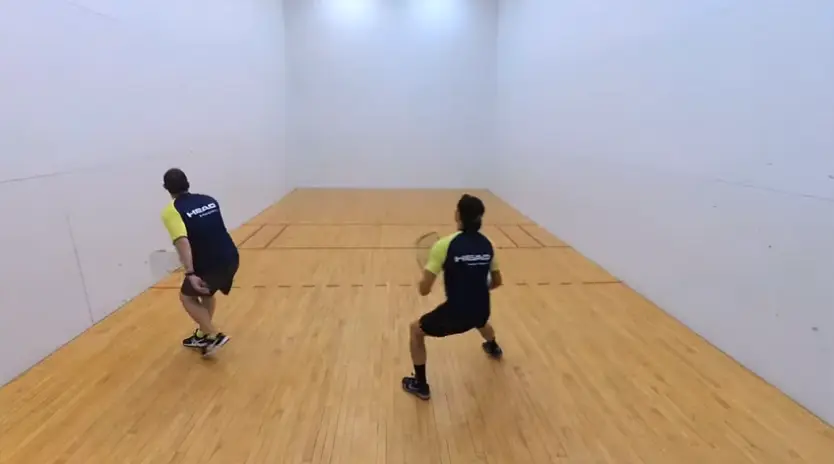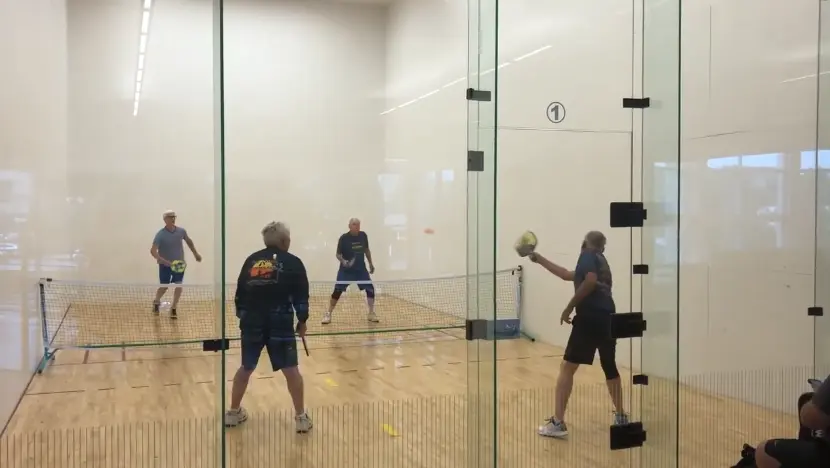Welcome to my article on pickleball vs. racquetball! As a fan of racket sports, I understand the growing popularity of games like pickleball, racquetball, and tennis worldwide.
In particular, pickleball has been making waves, attracting players from diverse backgrounds and experiencing a surge in interest. If you’re curious about the similarities and differences between pickleball and racquetball, you’ve come to the right place.
In this blog, I aim to provide you with comprehensive information on pickleball and racquetball. From equipment to court dimensions, rules, and scoring, you’ll find everything you need to know.
Both sports share similarities, such as the equipment used and the net, but there are significant differences that make each game unique.
By the end of this article, you’ll be equipped with valuable insights into pickleball and racquetball, surpassing the knowledge of most people on the street.
I’ll address the common questions about the similarities and differences between these two sports, shedding light on their histories, contributions, and their impact on the world of racket sports.
So, join me as we delve into the exciting world of pickleball and racquetball, and discover the unique charms and challenges that each sport offers. Let’s embark on this journey together and enhance your understanding of these distinct paddle sports.
Do Not Forget to Read: Overall Best Pickleball Paddles
Pickleball vs Racquetball:
Pickleball and racquetball are two distinct racket sports that offer unique gameplay experiences. While both sports share some similarities, they also have several key differences in terms of equipment, court design, rules, and gameplay.
Understanding these differences can help players choose the sport that aligns with their preferences and playstyle.
Court Design and Equipment

Do Not Forget to Read: Why Are Pickleball Paddles So Expensive
Pickleball and racquetball courts differ significantly in their design and layout. Pickleball courts are typically found outdoors and resemble badminton courts, although they are smaller than traditional tennis courts.
These courts feature specific lines, a net, and a non-volley zone. The non-volley zone, also known as the “kitchen,” is an area near the net where players are prohibited from hitting the ball in the air.
Pickleball paddles are used in this sport, which are made of lightweight materials and are smaller in size compared to racquetball racquets.
On the other hand, racquetball courts are typically indoor areas with four walls and a ceiling, creating an enclosed playing environment.
Do Not Forget to Read: Can You Play Pickleball On A Racquetball Court

Do Not Forget to Read: How To Make A Pickleball Practice Wall
Unlike pickleball, racquetball does not utilize a net. The racquetball racquets are made of aluminum or graphite frames and are larger than pickleball paddles. Racquetball racquets are measured in grams, while pickleball paddles are measured in ounces.
Playing Characteristics
The playing characteristics of pickleball and racquetball contribute to their distinct gameplay experiences. Pickleball is generally considered to be less physically demanding and places more emphasis on strategy and finesse.
It allows players more time to strategize due to its slower pace. Pickleball serves are underhand and must follow specific rules, while racquetball serves require the ball to bounce off the floor and front wall before being returned.
Racquetball, on the other hand, offers a fast-paced and physically demanding experience. It provides players with a cardio workout and tests their physical fitness.
The gameplay is faster, requiring more vigorous movement and strength compared to pickleball. Racquetball scoring is done by the serving team, with different score options available.
Scoring and Rules
The scoring systems in pickleball and racquetball also differ. In pickleball, only the serving team can score points, and a minimum two-point lead is required to win.
The game is typically played to 11 or 15 points. Racquetball follows a similar scoring system, with only the serving team able to score points. However, racquetball games are typically played to 15, 21, or 25 points.
Additionally, pickleball has a unique two-bounce rule for serves and returns, which means that the ball must bounce once on each side of the net before players can volley the ball in the non-volley zone. Racquetball does not have this rule.
Ball Characteristics
The balls used in pickleball and racquetball also contribute to the contrasting nature of these sports. Pickleball balls are made of lightweight composite plastic and have holes drilled through the plastic, which distinguishes them from balls used in other sports.

They have a softer texture and lower bounce, resulting in a slower-paced game that favors finesse and precise shot placement.Racquetballs, on the other hand, are made of rubber and are hollow. They have a higher bounce factor and move faster when struck.

The high bounce and speed of racquetballs create a faster-paced game that requires quick reflexes and agility.
Wrist Snap and Power Generation:
Racquetball players possess a valuable skill in the form of wrist snap, which enables them to generate power in their swings.
This skill translates well to pickleball, particularly in serves, overhead shots, and handling floating shots. The ability to execute a strong wrist snap contributes to powerful hits and enhances a player’s overall performance in both sports.
Ball Speed and Game Pace:
One notable difference between pickleball and racquetball is the speed of the ball. In pickleball, the ball generally moves at a slower pace compared to racquetball.
Even the most powerful overhead smashes in pickleball typically reach speeds of around 70 mph. This disparity in ball speed results in a slower-paced game overall when transitioning from racquetball to pickleball.
Agility and Footwork:
Agility and quick footwork are crucial skills that easily transfer from racquetball to pickleball. Racquetball players are accustomed to the lateral and front-to-back movements required in their sport, which can be directly applied to pickleball.

However, it is essential to note that pickleball is played with specific footwear, so racquetball players should ensure they have appropriate tennis shoes before taking to the pickleball court.
Adapting to Direct Shots:
One challenge racquetball players may encounter when transitioning to pickleball is adjusting to direct shots. Unlike racquetball, where shots are often played against the wall, elite pickleball players hit the ball directly at their opponents.
This change in trajectory and pace can take some time to get used to, as it requires quick reactions and paddle maneuvering to return the shots effectively.
Hitting Angles and Spin Control:
In racquetball, hitting the ball flat is the norm, with little emphasis on topspin or slice. Conversely, pickleball demands players to master hitting the ball from various angles on the paddle.
Understanding and executing shots with different paddle angles are essential skills to develop in pickleball. Additionally, racquetball players will need to adapt to handling various spins, such as topspin and side spins, which are commonly used in pickleball.
Team Sports with Different Equipment:
Both pickleball and racquetball are team sports played with a ball, but they differ in terms of the number of players and equipment used.
Pickleball typically involves four players on each side, while racquetball is played with two players. Moreover, pickleball utilizes a rubber ball, a paddle, and a net, whereas racquetball uses a hardball and a net.
Pickleball’s Unique Blend:
Pickleball is a sport that combines elements from tennis, table tennis, volleyball, and racquetball. Unlike racquetball, where a racquet is used, pickleball players employ their hands to hit the ball.
Additionally, the bounce of the ball in pickleball differs from that in racquetball, adding another layer of uniqueness to the game.
Smooth Transition for Racquetball Players:
Racquetball players often find it easier to adapt to pickleball due to the reduced physical contact and the opportunity for more strategic shots on open courts.

The skills acquired in racquetball, such as quick reactions, hand-eye coordination, and footwork, provide a solid foundation for racquetball players venturing into the world of pickleball.
Racquetball’s Popularity Challenges:
While racquetball is an intriguing sport, it does not enjoy the same level of popularity as tennis. One reason for this could be its limited movement options, which require players to constantly move their bodies to cover more space.
Nonetheless, racquetball offers a fast-paced and intense game experience that appeals to those seeking a high-energy workout.
Common Skills:
Both pickleball and racquetball share certain fundamental skills. Footwork plays a vital role in both sports, demanding quick and agile movements to reach the ball and position oneself for effective shots.
Good hand-eye coordination is necessary to track the ball and hit it precisely in both pickleball and racquetball. Strategy, quick reactions, and balance are additional essential skills that players must cultivate in both sports.
Personal Preferences and Goals:
Choosing between pickleball and racquetball ultimately depends on personal preferences and goals. Racquetball offers a fast-paced, intense game with a focus on power and movement.
On the other hand, pickleball provides a slower-paced game that emphasizes strategy, control, and placement. It is recommended to try both sports and gauge personal enjoyment and satisfaction to make an informed decision.
Fun and Exercise:
Regardless of the chosen sport, the primary focus should be on having fun and engaging in physical activity.
Both pickleball and racquetball offer enjoyable ways to stay active, improve skills, and socialize with others. The most important aspect is to select the sport that resonates most with individual interests and goals.
Do Not Forget to Read: How To Keep Score In Pickleball
Final word
In conclusion, pickleball and racquetball are two unique racket sports with distinct gameplay experiences. Pickleball is slower-paced, strategy-focused, and emphasizes finesse, while racquetball is fast-paced and physically demanding.
Players transitioning from racquetball to pickleball can leverage skills such as wrist snap and agility but may need to adapt to direct shots and different hitting angles. The choice between the two sports depends on personal preferences and goals.
Ultimately, both sports offer enjoyable ways to stay active and have fun. So, pick the sport that resonates with you and enjoy the exciting world of racket sports!
Do Not Forget to Read: Pickleball Drills For Beginners

Michael Stevenson
Hi, my name is Michael Stevenson and I’m a passionate pickleball player. I’ve been playing the game for many years and I’m pretty highly skilled at it. Pickleball is one of my favorite topics so naturally, I love to write about it.
Whether it’s tips for beginners, guides for experts, reviews of new paddles, or advanced playing techniques – if it relates to pickleball then I have something interesting to write about it. So if you’re looking for entertaining and informative information on the topic of pickleball, look no further than my written works!